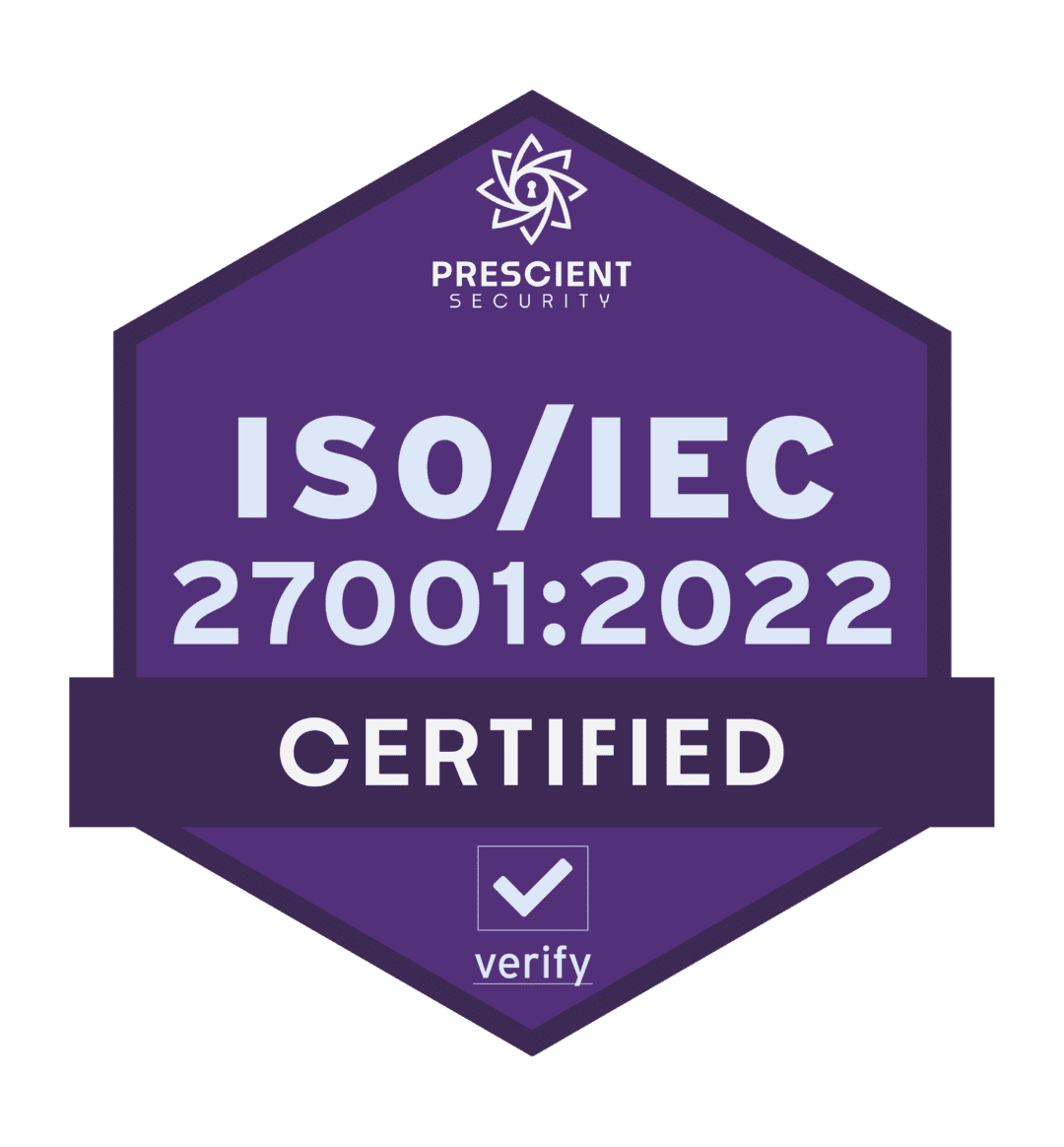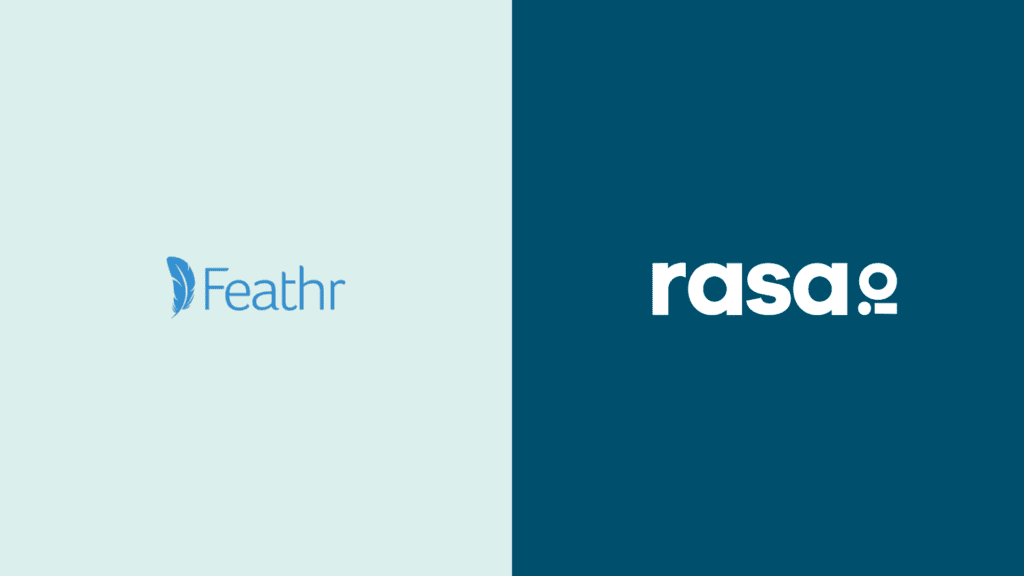Content marketing is a growing—but often underutilized—channel for real estate agents looking to connect with an existing or potential client. How does content marketing fit into a larger real estate marketing strategy? Let’s start with the basics.
What is content marketing?
Content marketing is a form of digital marketing that focuses on strategically creating, publishing and sharing relevant and useful informational content for a targeted audience. The key words here are relevant and useful.
The goal of content marketing is to inform existing and prospective clients. Content marketing goes beyond simply promoting real estate listings. Focus on creating and sharing content that is helpful to your audience, regardless of whether they’re buying or selling a home at the moment.
Impactful content marketing requires expertise and creativity. Think about how you can help your clients in a way that no one else can, in a format they will use.
What types of content marketing are in my toolkit?
From blog posts to videos, social media to email newsletters, content marketing comes in a range of formats and types. The upside? You have a ton of room to get creative with your real estate marketing. The downside? It can be a struggle to decide which format is best for carrying a specific message.
Real estate brands with successful content marketing often use a mix of formats to get content in front of their audience. Start by publishing content on your company’s website. Here’s an overview of eight types of content marketing that real estate agents need to have in their toolkit.
Blog Posts
Launching a blog is a straightforward way to get started with producing useful content for your audience. Blog posts are written and live on a website. They’re also super effective. Need more proof? The text you are currently reading is a blog post. If it works for you, it’ll work for your clients.
For example, take a look at Century 21’s real estate blog. Their blog includes posts highlighting Century 21 agents and has a few posts dedicated to real estate facts and figures. However, the bulk of the content addresses life at home. Their blog topics include lists of DIY home projects, a guide to organizing a closet or kitchen, and tips for entertaining house guests.
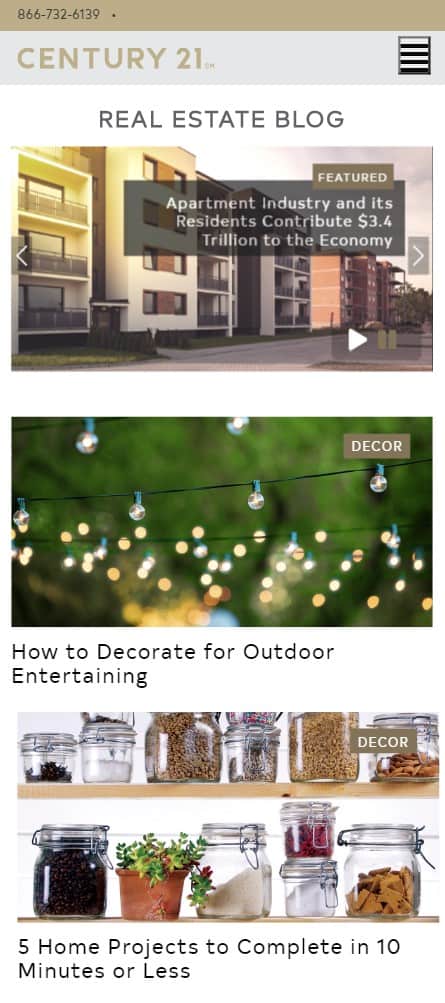
Source: Century 21 Real Estate LLC
Century21’s blog content appeals to a broad range of people who interface with the real estate business, from existing homeowners to renters looking to buy to those purchasing a vacation home. Good content marketing delivers value to a range of folks, not just clients.
Also, don’t be afraid to get personal with your blog posts. The majority of your clients are buying a home because they want to build a life there. Your blog is a way to connect with clients on the life building aspect of homeownership.
Consider the following tips for running a successful blog.
• Publish regularly, ideally 2-3 times a week.
• Aim for between 1,000 and 2,000 words per blog post.
• Provide valuable content to your audience, and make it easy for others to share your content on social media and on other websites.
• Experiment with different blog formats, like how-tos, guides, listicles and slides.
Video
Video is an increasingly powerful tool for real estate agents in connecting with clients. Real estate listings that include video receive more than five times as many inquiries than those without video, according to data gathered by Quicksprout.
Giving clients an inside peek at properties is one way to fold video into your content marketing, but don’t limit yourself to home tours. Do a walking tour of an up-and-coming neighborhood. Create video tutorials with ideas for small DIY home projects. If you’re comfortable on camera, give your take on the local market or explain the meaning behind common real estate terms.
Need inspiration? Check out the YouTube page for Zillow, the real estate database company. In addition to videos showcasing unique homes, the page offers short videos with home improvement hacks, homeowner profiles and tutorials for homebuyers.
Not quite ready to launch a YouTube channel just yet? Cut your teeth creating short, personable videos to share on social media.
Source: Zillow
eBooks
There are a lot of factors that go into the buying and selling of property. Many of those factors are a mystery to the average buyer and seller. An eBook gives your clients a deep dive look at specific topics, while also functioning as lead generators. Clients download the eBook after submitting a lead form with their contact information.
Writing an eBook takes some planning, but it’s doable. The first step is picking a topic that resonates with your audience. Potential ideas include guides for buying a home in a specific neighborhood in your area, for how to know when you’re ready to buy, or for finding an affordable home.
Take a cue from this eBook from Easy Agent Pro, which covers how to get your home ready for a sale. The eBook is formatted in Google Slides, which makes it easy to link to and share with their audience, and has a simple, approachable layout.
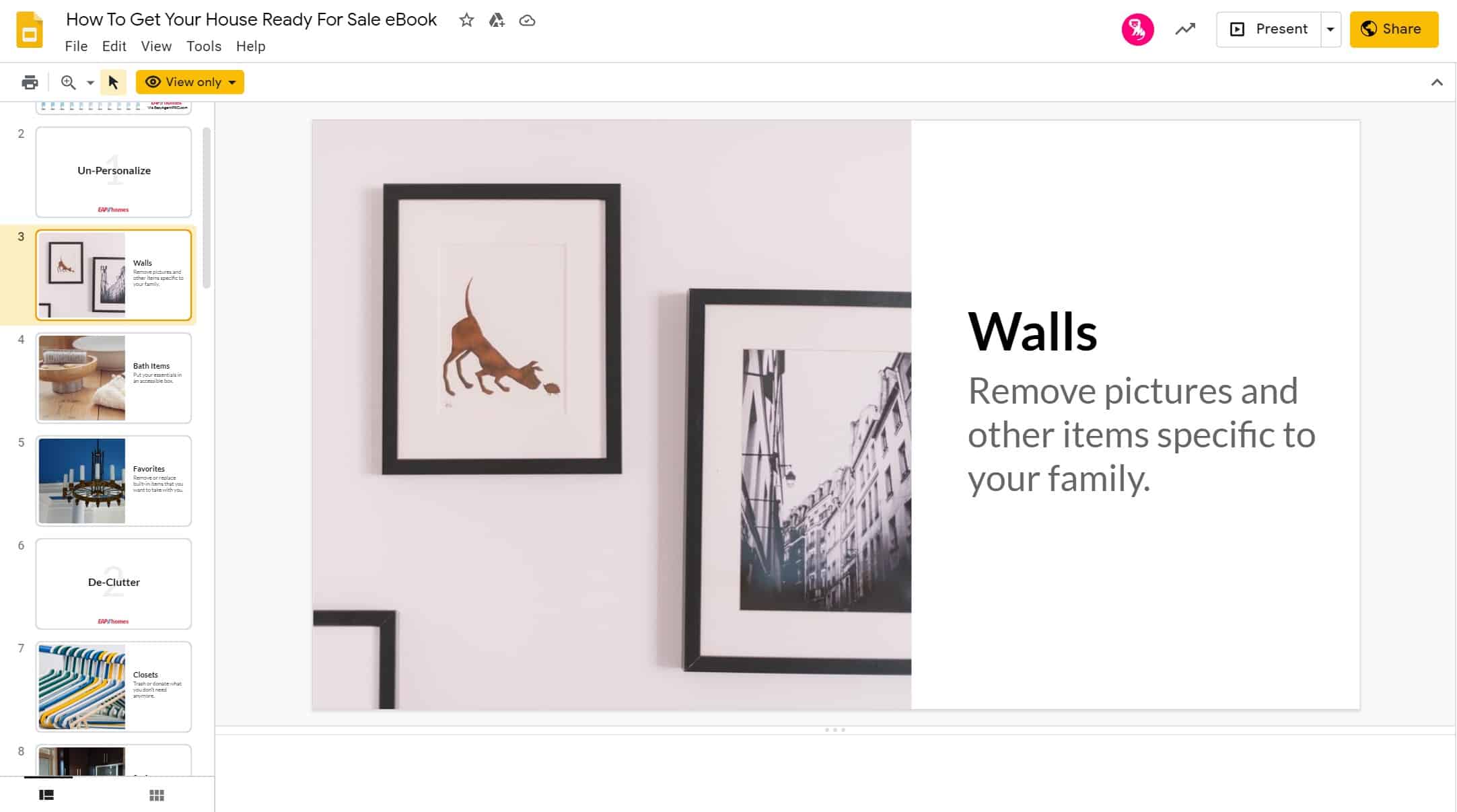
Source: Easy Agent Pro | www.easyagentpro.com
Email Newsletters
Roughly 93% of real estate agents prefer to communicate with their clients over email, which makes email newsletters a natural content fit.
The purpose of an email newsletter is to deliver informational content to your audience on a regular basis. Focus on sharing information about the news and topics your clients care about. For example, details on local schools, restaurants and events in their neighborhood; how-tos on managing personal finances as a homeowner; or explainers on how renovation projects affect the value of your home.
Fortunately, there is a range of technology, from simple GIFs to complex artificial intelligence, available to make it easier to build smarter, more personalized email newsletters. Want to get started sending a quality email newsletter fast? <Check out rasa.io’s platform, which leverages AI to make it easier to send more personalized email newsletters.
Check out our guide to creating a great real estate email newsletter.
Podcasts
Podcasts are hot right now. Nielsen characterized the recent growth in podcast listening among American adults as “tremendous” in a recent report, noting a 20% average growth rate of the country’s podcast listening audience. That audience grew by 3.6 million people in the past year, and is expected to double by 2023.
To be sure, launching a real estate podcast requires an investment in time and money. A podcast takes a good amount of planning before you hit record, including identifying:
• Your target audience;
• The real estate topics that will resonate and the right people to talk to; and
• The name and format your podcast will take.
DIY podcasters need basic audio equipment and software, namely a good USB microphone and a podcast recording and editing software, like Audacity or Adobe Audition. On the other hand, there are plenty of podcast editing companies that will help you record, edit and launch a quality podcast for free.
The main takeaway for real estate agents? If a podcast is part of your content strategy, devote a good amount of time to planning, find good people to talk to, and focus on topics that have broad appeal. A great example is Real Estate Guys Radio. This podcast has built a niche diving into the details of real estate investing and speaking to a topic that interests a broad group of folks: money.
Also, check out this detailed guide on how to launch a podcast from The Podcast Host for more detailed info if you’re considering this content option.
Templates
Like eBooks, templates are a handy way for real estate agents to share useful information while also generating leads. Template tools help meet a specific need among your audience, and save them time.
A good example is this real estate offer letter template from Fortunate Builders. It’s available as a downloadable PDF to guide homebuyers through drafting their own offer letters.
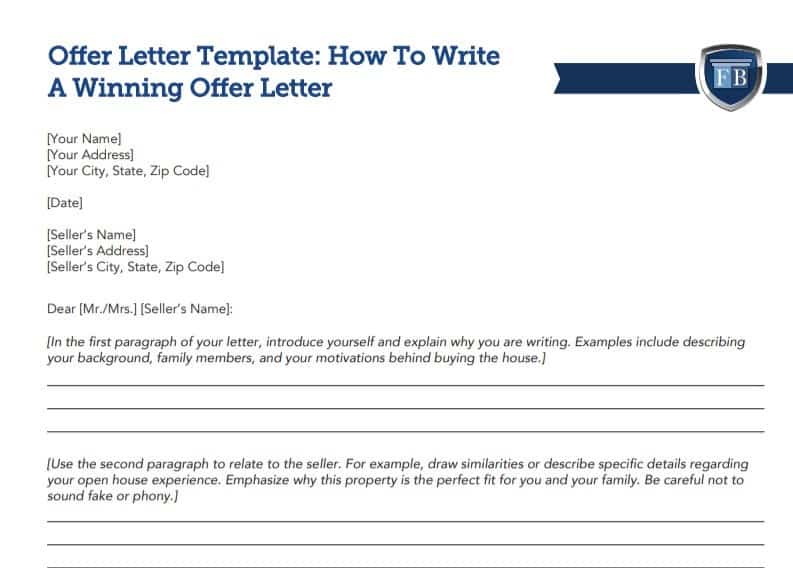
Source: Fortune Builders | www.fortunebuilders.com
Infographics
Infographics allow real estate agents to organize data and information in a visually compelling way, making it clear and easy-to-digest. The result? Content that catches more attention than text alone.
Take, for example, this moving out checklist from the Sunshine Momma blog (pictured below) or this Angie’s List infographic highlighting the five worst home improvements homeowners can make when it comes to resale value. Get more inspiration from this list of 97 real estate infographics from real estate website The Close.
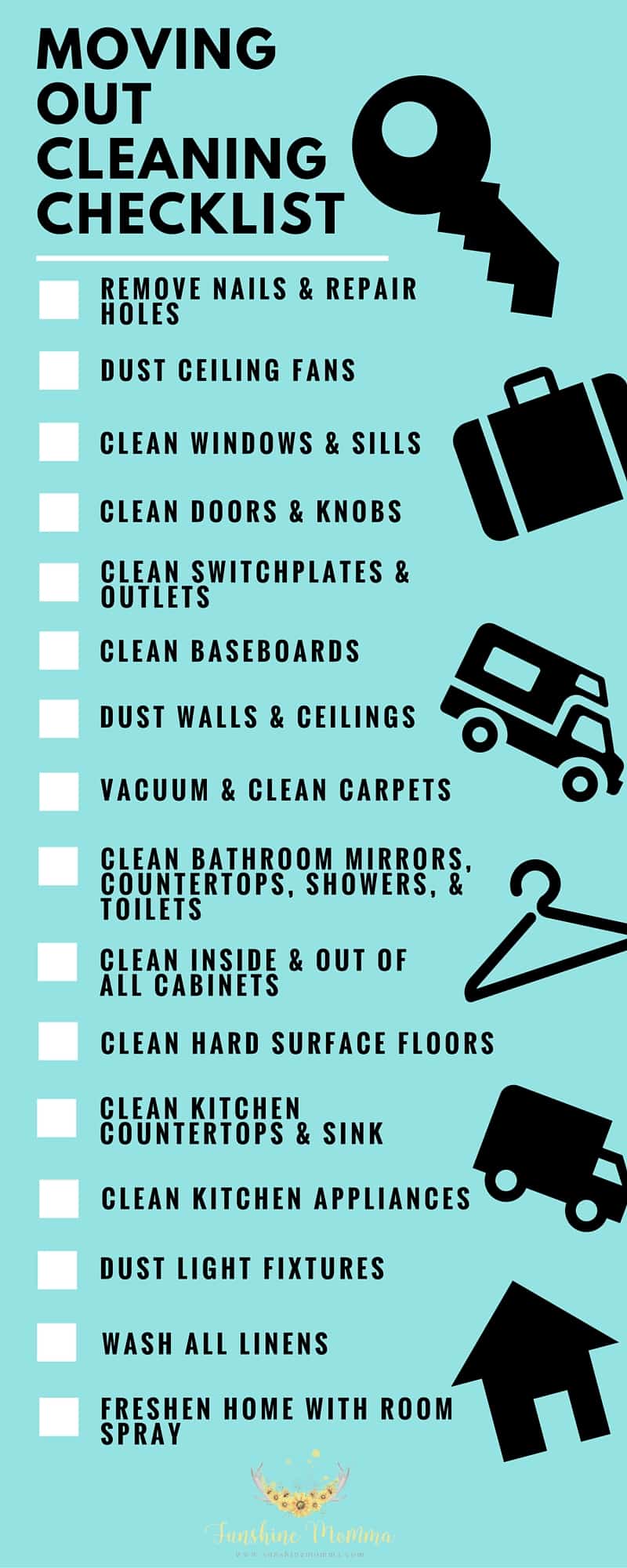
Source: Sunshine Momma Blog | www.sunshinemomma.com
Social media
Social media is a key tool for real estate agents to distribute content, especially once you’ve generated a solid pool of original content to pull from. Sharing content from your website blog on social media sites like Instagram, Facebook and Twitter amplifies your reach. It also meets your clients where they are spending their time. The average internet user worldwide spends more than two hours a day on social media, according to Statista.
Social networks on which real estate professionals post include:
• Snapchat
• YouTube
Each of the social media platforms above has a distinct content style. Be sure to keep that in mind when you launch a business account for your real estate brand. For example, Instagram puts an emphasis on visual content—photos, videos and graphics—that is user generated or goes behind-the-scenes at your agency, while Facebook content is more flexible, ranging from articles to videos and beyond. For example, Keller Williams Realty’s Instagram page offers a mix of graphics, infographics and visual guides, as well as photos of Keller Williams real estate agents from across the country.

Source: Keller Williams Realty | www.instagram.com/kellerwilliamsrealty
When planning your social media, adjust your content for platforms that are best suited for more intimate, one-on-one connections with clients (Snapchat, Instagram), and those that are more geared toward rapidly growing your reach (Facebook, Twitter and LinkedIn).
Original Content v. Curated Content
Do I need to create all of my own content?
The short answer is no. A robust content marketing strategy includes a healthy mix of original content and what is called curated content, or relevant content created by an outside source—for example, the Zillow blog or Better Homes and Gardens—that you share with your audience.
What is original content?
Content creation is the content your business develops on its own, like an original blog post, video tutorial or guide.
What is curated content?
Curated content, on the other hand, is existing content that is written or produced by someone else, but is useful and relevant to your audience. Sharing content curated from others is a good way to give your audience the latest info on a wide range of topics. “Isn’t that stealing?” you might ask. The answer is no—not if you’re curating the right way.
Curation, the process of sifting through online content and identifying what is relevant to your audience, is a key part of content marketing. Any curated content that you share should name and link back to the original source. You should also provide context for why you’re sharing it with your audience.
Let’s say you want to share a useful article from HGTV that explains how to refinish kitchen cabinets with your social media followers. Share the link, but also context for why you think it’s useful. How does a cabinet refresh affect your home’s marketability? When is the right time to start thinking about kitchen upgrades? Curated content, with credit and context, is just as useful as original content.
Sharing curated content is beneficial because it:
• Saves you time (and money);
• Enhances your relationships with other brands and content creators; and
• Elevates your brand as a go-to source for useful information.
Check out rasa.io’s free content curation guide to learn techniques for curating quality content faster.
Can I curate my brand’s original content?
Absolutely. Once your business starts generating enough content of its own, it’s possible to start curating your original content around specific topics. For example, a real estate firm that features a bathroom makeover each month on its YouTube channel can use that list to curate its most popular videos or a list of remodels that included a clawfoot tub installation.
The bottom line? There is a wide range of content types work into your real estate content marketing approach. Each takes time and planning, but it’s important for real estate agents to diversify the type of content they share.




